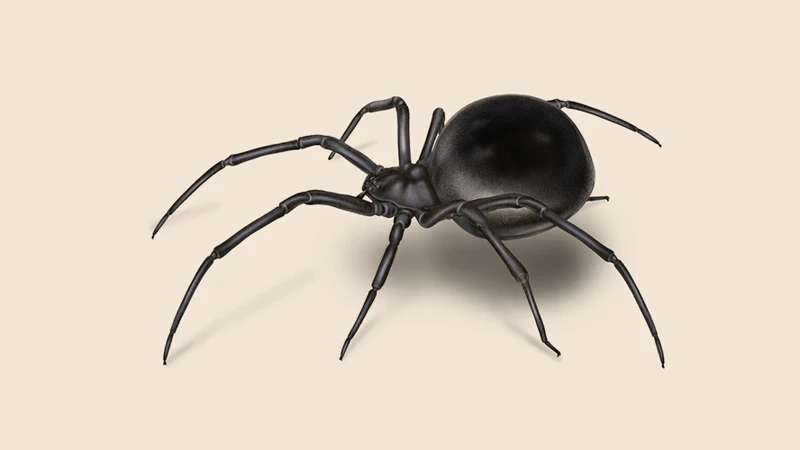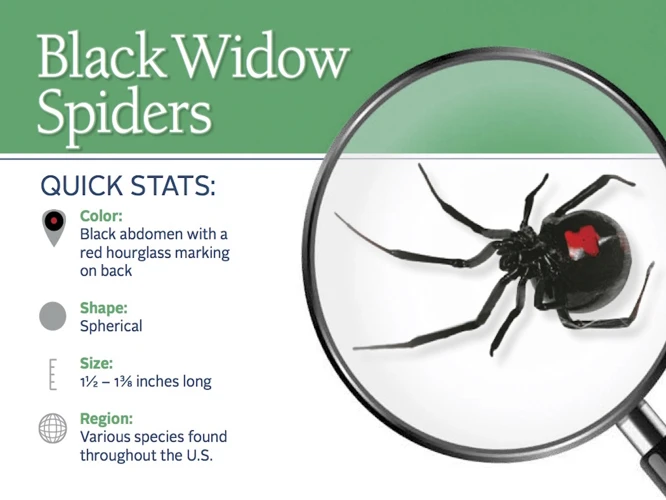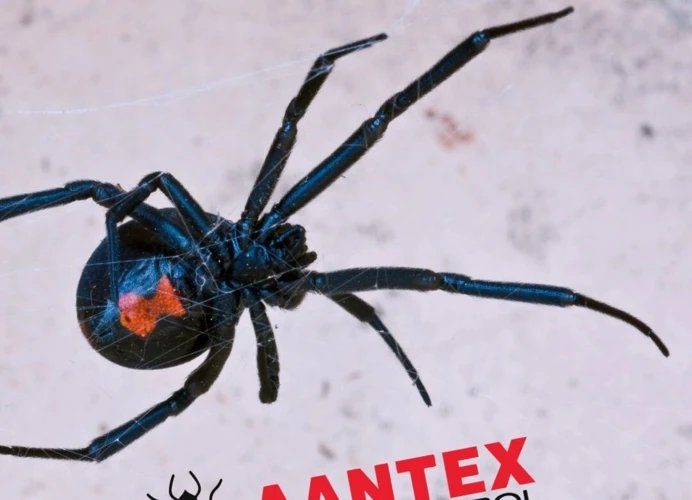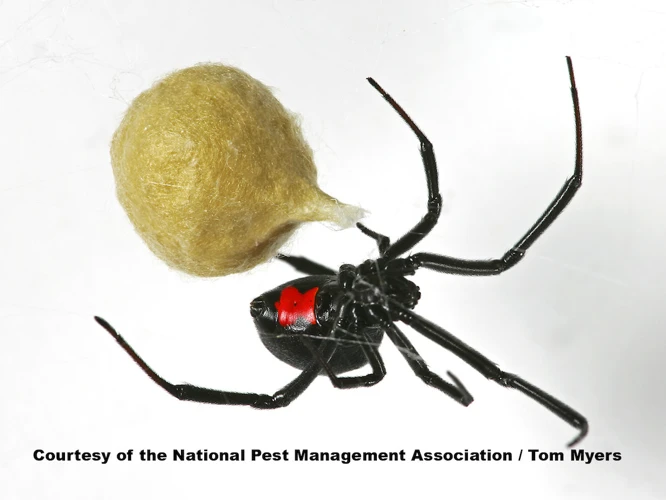As homeowners, it’s natural to want our living spaces to be safe and free of potential threats. Unfortunately, some of these threats come in the form of pests, like the infamous black widow spider. With their distinctive black coloring and venomous bite, black widows can be both unsettling and dangerous to have in and around your home. This guide will take you through step-by-step instructions on how to identify black widow spider habitats in your home, as well as tips for preventing and dealing with them if you do find them. So, let’s get started – your home’s safety is at stake!
Identifying Black Widow Spiders

How to Identify Black Widow Spiders
Black widow spiders are one of the most feared household pests due to their venomous bite. Knowing how to identify these spiders is crucial in order to avoid potential danger. Black widow spiders have distinct physical and behavioral characteristics that set them apart from other spider species. In this section, we’ll go over these identifying traits to help you spot a black widow spider habitat in your home. If you want to learn more about black widow spider habitats, check out this article.
Physical Characteristics
Black widow spiders have distinctive physical characteristics that make them easy to identify. Females are typically between 1.5 and 1.8 inches in length, while males are much smaller, around .75 inches in length. Both sexes have a shiny, black body that is round and bulbous in shape.
One of the most notable features of the black widow spider is its red hourglass-shaped marking on the underside of its abdomen. This marking is a key identifier of the black widow species. In addition to the hourglass marking, black widow spiders may have other red or white markings on their body.
It’s important to note that the physical characteristics of a black widow spider can vary depending on its gender, age and location. Younger black widows may have a striped pattern on their back. Additionally, black widow spiders in different regions may have different colors and patterns.
Below is a summary in a table of some of the distinguishing physical characteristics of black widow spiders.
| Characteristic | Description |
|---|---|
| Size | Females: 1.5-1.8 inches; Males: .75 inches |
| Body Shape | Round and bulbous |
| Color | Shiny black; may have red or white markings |
| Abdomen Marking | Red hourglass shape on the underside |
| Striped Pattern | Younger black widows may have a striped pattern on their back |
It’s important to learn to identify black widow spiders, as they can be dangerous and require attention. Knowing what black widow spiders look like is the first step in detecting whether your home has an infestation or not.
Behavioral Characteristics
Black widow spiders have some unique behavioral characteristics. Knowing these traits can help you better identify their habitats around your home. Here are some of the most notable behavioral characteristics of black widow spiders:
- Nocturnal behavior: Black widows are mainly active at night and hide during the daytime. They prefer dark, cool, and moist environments, which can help you locate their habitats.
- Attracted to certain habitats: Black widows prefer habitats like woodpiles, crevices, vegetation, and debris, which provide them with the ideal environment to spin their webs and capture prey.
- Hunting and feeding behavior: Black widows spin webs to capture and trap their prey. They usually feed on insects, including moths, flies, and grasshoppers. Their webs are known for their sticky, tangled nature, making it difficult for prey to escape after getting ensnared.
- Aggressive behavior: Black widows have a reputation for being aggressive towards humans, but they only attack if provoked. Their bite is venomous and can cause severe reactions, depending on the individual’s health condition and the amount of venom injected.
- Different behavior of males and females: Male and female black widows have different behaviors when it comes to mating. While the male spider looks for a mate, the female builds a web, lays eggs, and protects her habitat.
Understanding these behavioral characteristics of black widow spiders can help you identify their habitats easily and take necessary precautions to prevent their infestations. For instance, knowing that they prefer dark and moist environments, you can keep your surroundings clean and dry to eliminate potential habitats. A better understanding of spider habitat preferences will equip you with the knowledge needed to protect your home and family from these dangerous pests.
Where to Look for Black Widow Spider Habitats in Your Home

Where to Look for Black Widow Spider Habitats in Your Home: Now that you know how to identify black widow spiders, it is crucial to know where to look for their habitats in your house. These venomous spiders prefer to live in quiet and undisturbed areas, which makes it challenging to locate their hiding spots. However, we have put together a list of common areas where you can find their habitats. By being aware of these places, you’ll be better equipped to keep your home free of these dangerous spiders. Let’s take a closer look at where black widow spiders like to live. To learn more about spider habitat preferences, check out this article.
Indoors
When it comes to identifying black widow spider habitats indoors, it’s important to pay attention to certain areas that they are drawn to, such as:
| Area | Description |
|---|---|
| Cluttered spaces | Black widows tend to hide in dark, cluttered areas where they can spin their webs undisturbed. This can include piles of laundry, boxes, and other storage containers. |
| Unused items | Black widows also like to hide in areas that aren’t disturbed often. This can include unused shoes, sports equipment, and even old furniture. |
| Corners and crevices | Because black widows are shy by nature, they tend to hide in out-of-the-way areas like corners, baseboards, and the edges of ceilings. They may spin their webs in these areas and wait for prey to come to them. |
| Garages and sheds | Black widows are often found in garages and sheds where it’s dark and quiet. They may spin their webs on shelves, in corners, or inside boxes and storage containers. |
If you want to make your home an unappealing habitat for black widows, make sure to keep these areas clean, organized, and well-lit. By eliminating these potential hiding spots, you can reduce the likelihood of a black widow infestation.
Pro tip: If you do find a black widow spider inside your home, resist the urge to capture or kill it yourself. Instead, contact a professional pest control company like Eliminate Black Widow Spider Habitats Pest Control who can safely remove the spider without putting you or your family at risk.
Outdoors
When it comes to finding black widow spider habitats outdoors, it’s essential to know where to look. Black widows will typically build their webs in areas that are protected from the wind and rain. Here are some common places to check for black widow spider habitats:
- Underneath outdoor furniture: Tables, chairs, and other outdoor furniture items can provide shelter for black widows. Be sure to inspect the undersides of these pieces carefully.
- In woodpiles: Black widows will make their webs in woodpiles, especially those that are not frequently moved or disturbed. If you have a woodpile in your yard, make sure to wear gloves and long sleeves when moving the wood.
- In sheds or outbuildings: Any sort of outbuilding can be an attractive habitat for black widows, so be sure to check these structures carefully. Pay particular attention to dark corners and areas where clutter has accumulated.
- By pools or hot tubs: The area around your pool or hot tub can be an ideal habitat for black widows. Be sure to check areas where debris has accumulated, such as pool toys or covers.
- In rock piles: Rocks can provide excellent hiding spots for black widows. If you have a rock garden or decorative rocks in your yard, be sure to check these areas for spider webs.
It’s important to keep in mind that black widows prefer areas that are undisturbed and unappealing to predators, so any area that fits this description should be inspected regularly. If you notice an abandoned black widow spider habitat, it’s best to remove it as soon as possible to prevent the spiders from returning.
Preventing Black Widow Spiders in Your Home

Are you worried about black widow spiders making their home in your residence? Taking proactive measures can help you prevent black widow spiders from inhabiting your home. By making your home an unappealing habitat for them, you can keep them away for good. Let’s take a closer look at some effective ways to prevent black widow spiders from setting up shop in your living space.
One way to prevent black widow spiders is by removing clutter and debris. This creates an unappealing habitat for black widows and makes your home less inviting to them. Additionally, sealing cracks and openings in and around your home will help prevent them from entering. You can also change outdoor lighting, which can attract black widow spiders. By following these simple steps, you can reduce the chances of black widows ever inhabiting your home.
To learn more about where to look for black widow spider habitats in your home, check out our article on black widow spider habitats.
Sealing Cracks and Openings
Sealing cracks and openings is an essential step in preventing black widow spiders from entering your home. These spiders are small in size and can easily crawl through small openings. To ensure that they do not find their way inside, it’s important to seal up any cracks or gaps that could serve as an entry point.
How to Seal Cracks and Openings:
- Inspect the exterior of your home for any cracks or gaps in walls, roofs, window sills, or door frames. These can be sealed with caulking or weatherstripping.
- Seal up any openings where pipes, wires, or cables enter the home. This can be done with expanding foam or silicone caulking.
- Install screens on vents and chimney openings to prevent spiders from entering.
It is important to note that black widow spiders can also hide in outdoor clutter and debris, so it’s essential to keep the exterior of your home clean and free of any unappealing habitat for black widows. Removing abandoned black widow spider habitats from the exterior of the property can also help prevent these spiders from migrating indoors.
Human impact on black widow spider habitats is also a crucial factor that needs to be considered. Our failure to maintain our living spaces and leaving debris such as woodpiles, overgrown vegetation may lead to a proliferation of black widow spiders. Seal all cracks and openings in your home, dispose of debris and ensure your outdoor living spaces are maintained properly, and human impact on black widow spider habitats will dwindle.
By taking these preventative measures, you can reduce the chances of black widow spiders taking up residence in your home and keep you and your family safe. If you want to know more about common places black widow spiders hide out, check out this link /5-common-places-black-widow-spiders/.
Cleaning Clutter and Debris
Cleaning clutter and debris is an important step in preventing the formation of black widow spider habitats in your home. Black widow spiders thrive in environments with undisturbed clutter and debris, so it is crucial to keep your surroundings clean and clear of unwanted items. This not only ensures a safer living space for you but also makes your home an unappealing habitat for black widows.
To effectively clean clutter and debris, follow these simple steps:
- Identify areas with clutter and debris: Black widow spiders often reside in areas with undisturbed clutter and debris such as corners, basements, storage rooms, and garages.
- Organize and declutter: Remove all unnecessary items from these areas. Decluttering makes it easier to identify black widow spider habitats and also eliminates hiding spots for other pests.
- Vacuum: After decluttering, vacuum the area thoroughly, focusing on areas that are difficult to reach such as corners and crevices. This will remove spider webs and egg sacs, effectively disrupting the habitat.
- Regularly check and clean: Black widow spiders can return to build new webs and habitats if you do not clean regularly. It’s important to consistently monitor and clean cluttered areas.
It’s worth noting that human activity can also greatly contribute to the formation of black widow spider habitats. For example, abandoned or neglected items such as old tires, containers, and buckets can create an ideal environment for black widows to thrive. It’s essential to keep your surroundings tidy and be mindful of the items you leave unattended. By cleaning and organizing your surroundings regularly, you can significantly reduce the likelihood of black widow spider habitats in your home and minimize human impact on black widow spider habitats.
Changing Outdoor Lighting
Changing Outdoor Lighting
Believe it or not, the type of lighting you use around your home can greatly affect the presence of black widow spiders. This is because black widow spiders are attracted to insects that are attracted to light. By using yellow light bulbs or sodium vapor lamps instead of incandescent or white fluorescent bulbs, you can reduce the number of insects attracted to your home. This, in turn, will reduce the food sources available to black widow spiders and discourage them from setting up shop near your home.
Additionally, consider keeping outdoor lighting to a minimum. While having well-lit outdoor spaces is important for safety reasons, leaving the lights on all night can create an inviting environment for black widow spiders to spin their webs. Consider using motion-sensor lights or installing timers to automatically turn off outdoor lighting after a certain time.
Table: Pros and Cons of Different Types of Outdoor Lighting
| Type of Light | Pros | Cons |
|---|---|---|
| Incandescent | Produces warm, natural light | Attracts insects, including those that black widow spiders feed on |
| White Fluorescent | Energy-efficient | Attracts insects, including those that black widow spiders feed on |
| Yellow Light Bulbs | Attracts fewer insects than incandescent or white fluorescent bulbs | Produces a dimmer light (may not be ideal for certain outdoor spaces) |
| Sodium Vapor Lamps | Attracts fewer insects than incandescent or white fluorescent bulbs | Requires more energy to operate than other types of lighting |
By considering the type and amount of outdoor lighting you use, you can make your home less appealing to black widow spiders and reduce the chances of them turning your property into their habitat. If you suspect that there may already be a black widow spider habitat near your home, please refer to our article on abandoned black widow spider habitats to learn more about identifying and removing these pests.
What to Do If You Find a Black Widow Spider Habitat
Discovering a black widow spider habitat in your home can be a frightening experience. These venomous spiders are known for their painful bites and can pose a serious risk to your health and safety. In this section, we will explore the steps you should take if you come across a black widow spider habitat. It’s important to act quickly and carefully to remove the spiders to prevent any potential harm. So, let’s dive in and explore your options for dealing with these unwanted guests.
DIY Removal
If you have identified a black widow spider habitat in your home, it’s important to take action to remove the spiders as soon as possible. While professional removal services are available, it is possible to try a DIY removal first. However, it’s important to remember that black widow spiders are venomous, and it’s essential to take the proper safety precautions during removal. Here are some steps to take for successful DIY removal:
| Step | Description |
|---|---|
| Step 1: Identify the Spider | Before attempting to remove black widow spiders, it’s essential to confirm that you have identified the species correctly. Make sure to wear gloves to avoid being bitten, and use a flashlight to get a clear view of the spider’s physical characteristics. Remember that black widow spiders are shiny black with a distinctive red hourglass shape on their abdomen. |
| Step 2: Locate the Habitat | Black widow spiders tend to reside in dark, quiet areas near the floor and away from human traffic. Look for spider webs in corners, crevices, and other areas where the spider may be hiding. Use a broom to reach difficult areas or to move objects. Make sure to take regular breaks to avoid overexertion. |
| Step 3: Vacuum the Habitat | Once you have located the habitat, use a vacuum cleaner to remove the spider webs and spiders. Start by gently vacuuming around the habitat’s perimeter, working your way inward. Use the vacuum’s hose attachment to reach any difficult areas. Afterward, ensure that the vacuum bag is securely sealed and kept away from others. |
| Step 4: Dispose of the Vacuum Bag | It’s important to dispose of the vacuum bag immediately after using it to remove the spider habitat. Seal the bag securely inside a plastic bag and dispose of it in an outdoor trash bin. Make sure to wash your hands thoroughly after handling the vacuum bag. |
| Step 5: Monitor Your Home | After DIY removal, it’s important to monitor your home regularly to ensure that no new black widow spider habitats have formed. Keep your home clean, decluttered, and free of debris to prevent spiders from finding new hiding spots. |
While DIY removal can be an effective first step in removing black widow spider habitats, it’s essential to remember that these spiders are venomous, and their bites can be very dangerous. If you feel unsure about handling the situation, don’t hesitate to contact professional removal services for assistance.
Professional Removal
When it comes to removing black widow spider habitats from your home, it’s best to call in a professional. Removing a habitat without proper precautions can be dangerous. Professional removal experts have the knowledge, equipment, and experience to safely remove the spiders and their habitats from your home. Here are some of the benefits of hiring a professional for black widow spider removal:
| Benefits of Professional Removal |
|---|
| Expertise – Professional removal experts have the knowledge and experience to safely identify and remove black widow spider habitats. |
| Safety – Removing black widow spider habitats can be dangerous. Professional removal experts have the proper equipment to protect themselves and those around them. |
| Prevention – Professional removal experts can identify and seal entry points to prevent future black widow spider infestations. |
| Thoroughness – Professional removal experts have the training and experience to ensure that the entire black widow spider habitat is removed from your home. |
| Guarantee – Professional removal companies often offer a guarantee for their services which gives you peace of mind knowing that the problem will be completely solved. |
When you hire a professional removal expert, make sure to choose a reputable company with experience in black widow spider removal. Ask them about their methods and what precautions they take to ensure safety for themselves, your family, and your pets. With the right professional help, you can safely remove black widow spider habitats from your home and prevent future infestations.
Conclusion
After understanding the physical and behavioral characteristics of black widow spiders and where to look for their habitats in your home, it’s important to take preventative measures to avoid an infestation. Sealing cracks and openings, cleaning up clutter and debris, and changing outdoor lighting are all effective ways to reduce the likelihood of black widow spiders making their home in your house.
However, if you do find a black widow spider habitat in your home, it’s important to take action as soon as possible. DIY removal may work for some instances, but it’s important to take the proper precautions and use effective methods to ensure your safety. Hiring a professional removal service may be the best option to ensure that all black widow spiders and potential habitats are completely removed from your home.
While black widow spider bites can be dangerous, taking the proper steps towards prevention and removal can greatly reduce the risk of encountering these spiders in your home. By staying informed and implementing effective prevention measures, you can take control of your home’s safety and protect against black widow spider infestations. So stay vigilant, take action when needed, and keep your home safe from these harmful arachnids.
Frequently Asked Questions
1. What do black widow spiders look like?
Black widow spiders are glossy black in color with a distinct red hourglass shape on their abdomen. Females can measure up to 1.5 inches in length including their legs while males are smaller and are usually not a danger to humans.
2. Do all black widow spiders have the red hourglass marking?
No, not all black widow spiders have the red hourglass marking. Some may have markings that resemble lines or spots on their abdomen, while others may not have any discernible markings at all.
3. What are some signs of a black widow spider habitat in my home?
You may notice spider webs in dark, secluded areas such as garages, attics, and crawl spaces. Black widow spiders also tend to build messy webs that are usually irregular in shape.
4. Can black widow spiders thrive in cold climates?
No, black widow spiders do not thrive in cold climates. They prefer warm and humid environments and are typically found in the southern United States.
5. Are black widow spider bites always deadly?
No, not all black widow spider bites are deadly. While they can be very painful and cause serious symptoms, death from a black widow spider bite is rare. However, it is important to seek medical attention if you are bitten.
6. Should I attempt to remove a black widow spider habitat on my own?
If you are comfortable doing so, you can attempt to remove a black widow spider habitat on your own. However, it is important to take proper precautions such as wearing gloves and long clothing to protect yourself from potential bites.
7. How can I prevent black widow spiders from entering my home?
You can prevent black widow spiders from entering your home by sealing cracks and openings, keeping clutter and debris to a minimum, and changing your outdoor lighting to be less attractive to insects.
8. How can I tell if I have been bitten by a black widow spider?
Symptoms of a black widow spider bite may include sharp pain, swelling, muscle cramps, and nausea. If you suspect you have been bitten, seek medical attention immediately.
9. Can black widow spiders be beneficial in any way?
While black widow spiders are not typically seen as beneficial, they do play a role in controlling the populations of other insects and pests.
10. Will pest control companies guarantee the removal of black widow spiders?
Most pest control companies will not guarantee the removal of black widow spiders as they are a natural part of the ecosystem. However, they can assist in identifying and removing spider habitats.






